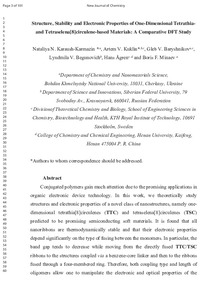Structure, stability and electronic properties of one-dimensional tetrathia-and tetraselena [8] circulene-based materials: a comparative DFT study
Скачать файл:
DOI:
10.1039/D0NJ00676AURI (для ссылок/цитирований):
https://pubs.rsc.org/en/content/articlehtml/2020/nj/d0nj00676ahttps://elib.sfu-kras.ru/handle/2311/142802
Автор:
Nataliya N Karaush-Karmazin
Artem, V Kuklin
Gleb, V Baryshnikov
Lyudmila, V Begunovich
Hans, Ågren
Boris, F Minaev
Коллективный автор:
Научно-исследовательская часть
Дата:
2020-05Журнал:
New Journal of ChemistryКвартиль журнала в Scopus:
Q1Квартиль журнала в Web of Science:
Q2Библиографическое описание:
Nataliya N Karaush-Karmazin. Structure, stability and electronic properties of one-dimensional tetrathia-and tetraselena [8] circulene-based materials: a comparative DFT study [Текст] / Nataliya N Karaush-Karmazin, V Kuklin Artem, V Baryshnikov Gleb, V Begunovich Lyudmila, Ågren Hans, F Minaev Boris // New Journal of Chemistry. — 2020. — Т. 44 (№ 17). — С. 6872-6882Аннотация:
Conjugated polymers gain much attention due to the promising applications in organic electronic device technology. In this work, we theoretically study the structures and electronic properties of a novel class of nanostructures, namely one-dimensional tetrathia[8]circulenes (TTC) and tetraselena[8]circulenes (TSC) predicted to be promising semiconducting soft materials. It is found that all nanoribbons are thermodynamically stable and that their electronic properties depend significantly on the type of fusing between the monomers. In particular, the band gap tends to decrease while moving from the directly fused TTC/TSC ribbons to the structures coupled via a benzene-core linker and then to the ribbons fused through a four-membered ring. Therefore, both coupling type and length of oligomers allow one to manipulate the electronic and optical properties of the studied ribbons. The band structure calculations of infinite nanoribbons reveal direct band gaps that decrease from 2.28 to 2.14 eV for the TTC ribbons of the first and second fusion types. The TSC structures demonstrate the same trend exhibiting band gap narrowing from 2.41 (type I) up to 2.11 eV (type II). The type III ribbons possess a lack of periodicity due to the close-lying energy minima for the possible twisting configurations of TTC and TSC moieties relative to the linking four-membered ring.

